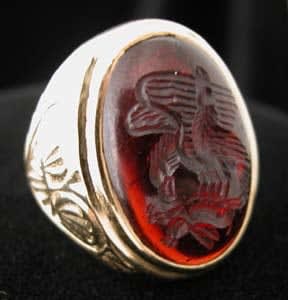Gold Ring with Classical Revival Garnet Intaglio of an Eagle Carrying off a Rabbit, 18th Century CE
Garnet and Gold
FJ.6621
Further images
The art of glyptics, or carving on colored precious stones, is probably one of the oldest known to humanity. Intaglios, gems with an incised design, were made as early as...
The art of glyptics, or carving on colored precious stones, is probably one of the oldest known to humanity. Intaglios, gems with an incised design, were made as early as the fourth and third millennia B.C. in Mesopotamia and the Aegean Islands. They exhibit a virtuosity of execution that suggests an old and stable tradition rooted in the earliest centuries. The tools required for carving gems were simple: a wheel with a belt-drive and a set of drills. A special difficulty of engraving intaglios, aside from their miniature size, was that the master had to work with a mirror-image in mind.
The Classical Revival was a phenomenon that swept through Europe in the 18th and 19th Centuries. A new appreciation for antiquity and ancient art forms was fostered by discoveries in the nascent scientific field of archaeology. Perhaps the Classical Revival also reveals a latent longing towards the Arcadian lifestyles of yesterday abandoned as Europe became rapidly industrialized and increasingly urbanized. Engraved upon the polished surface of this precious gemstone is a scene of an eagle soaring through the sky, carrying a rabbits in its talons. We can imagine this majestic bird swooping down from the sky and catching the unsuspecting rabbit in its deadly talons. Throughout time, eagles have been admired for their keen eyesight and their lightning speed. In fact, the eagle was the symbol for the king of the gods, Zeus (known as Jupiter to the Romans). This gorgeous ring evokes the beauty of the Classical world after which it was inspired.
The Classical Revival was a phenomenon that swept through Europe in the 18th and 19th Centuries. A new appreciation for antiquity and ancient art forms was fostered by discoveries in the nascent scientific field of archaeology. Perhaps the Classical Revival also reveals a latent longing towards the Arcadian lifestyles of yesterday abandoned as Europe became rapidly industrialized and increasingly urbanized. Engraved upon the polished surface of this precious gemstone is a scene of an eagle soaring through the sky, carrying a rabbits in its talons. We can imagine this majestic bird swooping down from the sky and catching the unsuspecting rabbit in its deadly talons. Throughout time, eagles have been admired for their keen eyesight and their lightning speed. In fact, the eagle was the symbol for the king of the gods, Zeus (known as Jupiter to the Romans). This gorgeous ring evokes the beauty of the Classical world after which it was inspired.





